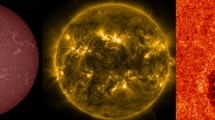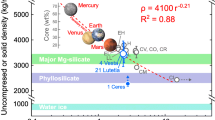Abstract
The past decade has seen a wealth of new data, mainly from the Galilean satellites and Mars, but also new information on Mercury, the Moon and asteroids (meteorites). In parallel, there have been advances in our understanding of dynamo theory, new ideas on the scaling laws for field amplitudes, and a deeper appreciation on the diversity and complexity of planetary interior properties and evolutions. Most planetary magnetic fields arise from dynamos, past or present, and planetary dynamos generally arise from thermal or compositional convection in fluid regions of large radial extent. The relevant electrical conductivities range from metallic values to values that may be only about one percent or less that of a typical metal, appropriate to ionic fluids and semiconductors. In all planetary liquid cores, the Coriolis force is dynamically important. The maintenance and persistence of convection appears to be easy in gas giants and ice-rich giants, but is not assured in terrestrial planets because the quite high electrical conductivity of an iron-rich core guarantees a high thermal conductivity (through the Wiedemann-Franz law), which allows for a large core heat flow by conduction alone. This has led to an emphasis on the possible role of ongoing differentiation (growth of an inner core or “snow”). Although planetary dynamos mostly appear to operate with an internal field that is not very different from (2ρΩ/σ)1/2 in SI units where ρ is the fluid density, Ω is the planetary rotation rate and σ is the conductivity, theoretical arguments and stellar observations suggest that there may be better justification for a scaling law that emphasizes the buoyancy flux. Earth, Ganymede, Jupiter, Saturn, Uranus, Neptune, and probably Mercury have dynamos, Mars has large remanent magnetism from an ancient dynamo, and the Moon might also require an ancient dynamo. Venus is devoid of a detectable global field but may have had a dynamo in the past. Even small, differentiated planetesimals (asteroids) may have been capable of dynamo action early in the solar system history. Induced fields observed in Europa and Callisto indicate the strong likelihood of water oceans in these bodies. The presence or absence of a dynamo in a terrestrial body (including Ganymede) appears to depend mainly on the thermal histories and energy sources of these bodies, especially the convective state of the silicate mantle and the existence and history of a growing inner solid core. As a consequence, the understanding of planetary magnetic fields depends as much on our understanding of the history and material properties of planets as it does on our understanding of the dynamo process. Future developments can be expected in our understanding of the criterion for a dynamo and on planetary properties, through a combination of theoretical work, numerical simulations, planetary missions (MESSENGER, Juno, etc.) and laboratory experiments.
Similar content being viewed by others
References
M.H. Acuna, J.E.P. Connerney, P. Wasilewski et al., Magnetic field of Mars: Summary of results from the aerobraking and mapping orbits. J. Geophys. Res. Planet. 106, 23403–23417 (2001)
O. Aharonson, M.T. Zuber, S.C. Solomon, Crustal remanence in an internally magnetized non-uniform shell: a possible source for Mercury’s magnetic field? Earth Planet. Sci. Lett. 218, 261–268 (2004)
B.J. Anderson, M.H. Acuna, H. Korth et al., The structure of Mercury’s magnetic field from MESSENGER’s first flyby. Science 321, 82–85 (2008)
J. Arkani-Hamed, Did tidal deformation power the core dynamo of Mars? Icarus 201, 31–43 (2009)
B.A. Buffett, J. Bloxham, Energetics of numerical geodynamo models. Geophys. J. Int. 149, 211–224 (2002)
B.A. Buffett, E.J. Garnero, R. Jeanloz, Sediments at the top of Earth’s core. Science 290, 138–1342 (2000)
F.H. Busse, Homogeneous dynamos in planetary cores and in the laboratory. Annu. Rev. Fluid Mech. 32, 383–408 (2000)
B. Chen, J. Li, S.A. Hauck, Non-ideal liquidus curve in the Fe–S system and Mercury’s snowing core. Geophys. Res. Lett. 35, L07201 (2008)
U.R. Christensen, A deep dynamo generating Mercury’s magnetic field. Nature 444, 1056–1058 (2006)
U.R. Christensen, J. Wicht, Models of magnetic field generation in partly stable planetary cores: applications to Mercury and Saturn. Icarus 196, 16–34 (2008)
U.R. Christensen, J. Aubert, P. Cardin et al., A numerical dynamo benchmark. Phys. Earth Planet. Int. 128, 25–34 (2001)
U.R. Christensen, V. Holzwarth, A. Reiners, Energy flux determines magnetic field strength of planets and stars. Nature 457, 167–169 (2009)
D.D. Clayton, Principles of Stellar Evolution and Nucleosynthesis (McGraw-Hill, New York, 1968), 256 pp.
I. De Pater, J.J. Lissauer, Planetary Sciences (Cambridge University Press, New York, 2001), 528 pp.
M. French, T.R. Mattsson, N. Nettelmann et al., Equation of state and phase diagram of water at ultrahigh pressures as in planetary interiors. Phys. Rev. B 79 (2009). Article Number: 054107
I. Garrick-Bethell, B.P. Weiss, D.L. Shuster et al., Early Lunar magnetism. Science 323, 356–359 (2009)
C.K. Gessmann, B.J. Wood, D.C. Rubie, M.R. Kilburn, Solubility of silicon in liquid metal at high pressure: implications for the composition of the Earth’s core. Earth Planet. Sci. Lett. 184, 367–376 (2001)
G. Giampieri, A. Balogh, Mercury’s thermoelectric dynamo model revisited. Planet. Space Sci. 50, 757–762 (2002)
D. Grodent, B. Bonfond, J.C. Gerard et al., Auroral evidence of a localized magnetic anomaly in Jupiter’s northern hemisphere. J. Geophys. Res. 113, A09201 (2008)
D. Gubbins, Energetics of the Earth’s core. J. Geophys. 47, 453–464 (1977)
D. Gubbins, The Rayleigh number for convection in the Earth’s core. Phys. Earth Planet. Int. 128, 3–12 (2001)
T. Guillot, Interiors of giant planets inside and outside the solar system. Science 286, 72–77 (1999)
L.L. Hood, A. Zakharian, J. Halekas et al., Initial mapping and interpretation of lunar crustal magnetic anomalies using Lunar Prospector magnetometer data. J. Geophys. Res. Planet. 106, 27825–27839 (2001)
W.B. Hubbard, M. Podolak, D.J. Stevenson, The interior of Neptune, in Neptune. Un. Arizona Space Science Series (1995), pp. 109–138
C.A. Jones, Convection-driven geodynamo models. Philos. Trans. Roy. Soc. A 358, 873–897 (2000)
A. Kageyama, T. Miyagoshi, T. Sato, Formation of current coils in geodynamo simulations. Nature 454, 1106–1109 (2008)
M.G. Kivelson, J. Warnecke, L. Bennett et al., Ganymede’s magnetosphere: magnetometer overview. J. Geophys. Res. Planet. 103, 19963–19972 (1998)
M.G. Kivelson, K.K. Khurana, C.T. Russell et al., Magnetized or unmagnetized: ambiguity persists following Galileo’s encounters with Io in 1999 and 2000. J. Geophys. Res. Space 106, 26121–26135 (2001)
S. Labrosse, J.-P. Poirier, J.-L. Le Mouel, The age of the inner core. Earth Planet. Sci. Lett. 190, 111–123 (2001)
V. Lainey, J.E. Arlot, O. Karatekin et al., Strong tidal dissipation in Io and Jupiter from astrometric observations. Nature 459, 957–959 (2009)
J.-J. Liu, P. Goldreich, D.J. Stevenson, Ohmic dissipation constraint on deep-seated zonal winds in Jupiter and Saturn. Icarus 196, 653–664 (2008)
D.E. Loper, Some thermal consequences of a gravitationally powered geodynamo. J. Geophys. Res. 83, 5961–5970 (1978)
J.L. Margot, S.J. Peale, R.F. Jurgens et al., Large longitude libration of Mercury reveals a molten core. Science 316, 710–714 (2007)
R.T. Merrill, M.W. McElhinney, P.L. McFadden, The Magnetic Field of the Earth (Academic Press, New York, 1996), 531 pp.
H.K. Moffatt, Magnetic Field Generation in Electrically Conducting Fluids (Cambridge University Press, New York, 1978), 336 pp.
W.J. Nellis, Metallization of fluid hydrogen at 140 GPa (1.4 Mbar): implications for Jupiter. Planet. Space Sci. 48, 671–677 (2000)
W.J. Nellis, N.C. Holmes, A.C. Mitchell et al., Equation of state and electricalconductivity of “synthetic Uranus”, a mixture of water, ammonia, and isopropanol, at shock pressure up to 200 GPa (2 Mbar). J. Chem. Phys. 107, 9096–9100 (1997)
F. Nimmo, Energetics of asteroid dynamos and the role of compositional convection. Geophys. Res. Lett. 36, L10201 (2009)
F. Nimmo, D.J. Stevenson, Influence of early plate tectonics on the thermal evolution and magnetic field of Mars. J. Geophys. Res. Planet. 105, 11969–11979 (2000)
E.N. Parker, Cosmical Magnetic Fields: Their Origin and Their Activity (Clarendon Press and Oxford University Press, New York, 1979), 841 pp.
J.-P. Poirier, Introduction to the Physics of the Earth’s Interior (Cambridge University Press, New York, 1991), p. 191
J.-P. Poirier, Light-elements in the Earth’s outer core—a critical-review. Phys. Earth Planet. Int. 85, 319–337 (1994)
P. Roberts, G.A. Glatzmaier, Geodynamo theory and simulations. Rev. Modern Phys. 72, 1081–1123 (2000)
G. Schubert, M.N. Ross, D.J. Stevenson, T. Spohn, T. Mercury’s thermal history and the generation of its magnetic field, in Mercury, ed. by C. Chapman et al. (University of Arizona Press, Tucson, 1988), pp. 429–460
G. Schubert, V.S. Solomatov, P.J. Tackley, D.L. Turcotte, Mantle Convection and the thermal evolution of Venus, in Venus II, ed. by S.W. Bougher, D.M. Hunten, R.J. Phillips (University of Arizona Press, Tucson, 1998), pp. 429–460
S. Stanley, J. Bloxham, Convective-region geometry as the cause of Uranus’ and Neptune’s unusual magnetic fields. Nature 428, 151–153 (2004)
S. Stanley, J. Bloxham, Numerical dynamo models of Uranus’ and Neptune’s magnetic fields. Icarus 184, 556–572 (2006)
S. Stanley, J. Bloxham, W.E. Hutchison, M.T. Zuber, Thin shell dynamo models consistent with Mercury’s weak observed magnetic field. Earth Planet. Sci. Lett. 234, 27–38 (2005)
D.J. Stevenson, Turbulent thermal convection in the presence of rotation and a magnetic field: a heuristic theory. Geophys. Astrophys. Fluid Dyn. 12, 139–169 (1979)
D.J. Stevenson, Reducing the non-axisymmetry of a planetary dynamo and an application to Saturn. Geophys. Astrophys. Fluid Dyn. 21, 113–127 (1982)
D.J. Stevenson, Planetary magnetic fields. Rep. Progr. Phys. 46, 555–620 (1983)
D.J. Stevenson, Limits on lateral density and velocity variations in the Earth’s outer core. Geophys. J. Roy. Astron. Soc. 88, 311–319 (1987a)
D.J. Stevenson, Mercury’s magnetic field—a thermoelectric dynamo. Earth Planet. Sci. Lett. 82, 114–120 (1987b)
D.J. Stevenson, Europa’s ocean—the case strengthens. Science 289, 1305–1307 (2000)
D.J. Stevenson, Mars’ core and magnetism. Nature 412, 214–219 (2001)
D.J. Stevenson, Introduction to planetary interiors, in Proceedings of the International School of Physics “Enrico Fermi” (Italian Physical Society, Bologna, 2002)
D.J. Stevenson, Planetary magnetic fields. Earth Planet. Sci. Lett. 208(2003), 1–11 (2003)
D.J. Stevenson, T. Spohn, G. Schubert, Magnetism thermal evolution of the terrestrial planets. Icarus 54, 466–489 (1983)
A.J. Stewart, M.W. Schmidt, W. van Westrenen, C. Liebske, Mars: a new core-crystallization regime. Science 316, 1323–1325 (2007)
B.P. Weiss, J.S. Berdahl, L. Elkins-Tanton et al., Magnetism on the angrite parent body and the early differentiation of planetesimals. Science 322, 713–716 (2008a)
B.P. Weiss, L.E. Fong, H. Vali et al., Paleointensity of the ancient Martian magnetic field. Geophys. Res. Lett. 35, L23207 (2008b)
J.G. Williams, D.H. Boggs, C.F. Yoder et al., Lunar rotational dissipation in solid body and molten core. J. Geophys. Res. Planet. 106, 27933–27968 (2001)
J.P. Williams, O. Aharonson, F. Nimmo, Powering Mercury’s dynamo. Geophys. Res. Lett. 34, L21201 (2007)
C. Zimmer, K.K. Khurana, M.G. Kivelson, Subsurface oceans on Europa and Callisto: constraints from Galileo magnetometer observations. Icarus 147, 329–347 (2000)





